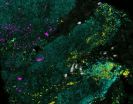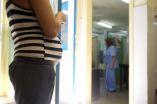(Press-News.org) WOODS HOLE, Mass.--Since the first "catalog" of the normal bacterial makeup of the human body was published in 2012, numerous connections between illness and disturbances in the human microbiota have been found. This week, scientists report yet another: Cancerous tumors in the ascending colon (the part nearest to the small intestine) are characterized by biofilms, which are dense clumps of bacterial cells encased in a self-produced matrix.
"This is the first time that biofilms have been shown to be associated with colon cancer, to our knowledge," says co-author Jessica Mark Welch, a scientist at the Marine Biological Laboratory (MBL) in Woods Hole, Mass.
The discovery, led by researchers at the Johns Hopkins Medical Institutions, draws on a novel way to "see" microbial community structure that was developed by Mark Welch and colleagues at the MBL. Called combinatorial imaging, it could potentially be used to clinically diagnose pre-cancerous and cancerous conditions in the ascending colon.
In healthy people, the colon is covered in a mucus layer (mucosa) that helps keep bacteria away from the colon's "skin," or epithelia. Remarkably, the team found that colon cancer patients who have tumor-associated biofilms also have biofilms on tumor-free areas of the nearby mucosa.
"This suggests that either the tumor allows the biofilm to form, or the biofilm is helping to cause the tumor," says Mark Welch. "The breaching of the mucus layer could allow bacteria to come into contact with the host epithelial cells, and that is one thing that could lead to cancer."
The team found that tumors in the descending colon (going to the rectum) do not have associated biofilms.
Mark Welch and MBL co-authors Gary Borisy (now at the Forsyth Institute) and Blair Rossetti are among a group of MBL scientists who invented the combinatorial imaging technique used in this research. Different colors of fluorescent probes (nine in this study) "light up" different species of bacteria in the biofilm, revealing the 3-D structure of its microbial community. They found that the biofilms associated with ascending colon tumors are composed of many species of bacteria; they are diverse (non-identical); and that the part of the biofilm that invades the mucosal layer contains a subset of all the bacterial strains in the biofilm, rather than just one invading strain.
INFORMATION:
Citation:
Dejea CM et al (2014) Microbiota organization is a distinct feature of proximal colorectal cancers. PNAS: doi: 10.1073/pnas.1406199111.
The Marine Biological Laboratory (MBL) is dedicated to scientific discovery and improving the human condition through research and education in biology, biomedicine, and environmental science. Founded in Woods Hole, Massachusetts, in 1888, the MBL is a private, nonprofit institution and an affiliate of the University of Chicago.
PITTSBURGH--An interest in the gender gap between the representations of female candidates in U.S. elections compared to their male counterparts led two University of Pittsburgh professors to take the issue into the laboratory for three years of research.
Associate Professors of Political Science Kristin Kanthak and Jonathan Woon have published an article about the first phase of their research findings. "Women Don't Run? Election Aversion and Candidate Entry" was published online Dec. 2 in the American Journal of Political Science.
"Past research has shown that women ...
A group of researchers from Recep Tayyip Erdoğan University, Faculty of Fisheries in Turkey discovered a new trout species. The newly described species Salmo kottelati, belongs to the Salmonidae family, which includes salmons, trouts, chars, graylings and freshwater whitefishes.
Salmonids include over 200 species, which have a high economic value because of their taste and famed sporting qualities.
The genus Salmo is widely distributed in rivers and streams of basins of the Marmara, Black, Aegean and Mediterranean seas. The genus is represented by 12 species in ...
In a contribution to an extraordinary international scientific collaboration the University of Sydney found that genomic 'fossils' of past viral infections are up to thirteen times less common in birds than mammals.
"We found that only found only five viral families have left a footprint in the bird genome (genetic material) during evolution. Our study therefore suggests that birds are either less susceptible to viral invasions or purge them more effectively than mammals," said Professor Edward Holmes, from the University of Sydney's Charles Perkins Centre, School of ...
A new study analyses the violent behaviours exhibited towards pregnant women. While 21% of women suffer emotional violence during pregnancy, 3.6% encounter physical or sexual violence. Furthermore, 36.1% of those who reported physical violence claimed that it happened "very often" or "daily".
Whilst for many women pregnancy is a happy time, for almost one in four it turns out not to be so enjoyable. An investigation into the prevalence of domestic violence against pregnant women has found that 22.7% endure some kind of violence - emotional, physical or sexual - within ...
For the first time researchers have measured large distances in the Universe using data, rather than calculations related to general relativity.
A research team from Imperial College London and the University of Barcelona has used data from astronomical surveys to measure a standard distance that is central to our understanding of the expansion of the universe.
Previously the size of this 'standard ruler' has only been predicted from theoretical models that rely on general relativity to explain gravity at large scales. The new study is the first to measure it using ...
About 95 percent of the more than 10,000 bird species known only evolved upon the extinction of dinosaurs about 66 million years ago. According to computer analyses of the genetic data, today's diversity developed from a few species at a virtually explosive rate after 15 million years already. KIT scientists designed the algorithms for the comprehensive analysis of the evolution of birds. To obtain the results that are now presented in the Science journal, a computing capacity of 300 processor-years was required. (DOI 10.1126/science.1253451)
"Computation of these trees ...
This news release is available in Spanish. What is more, this study is the first one conducted using forensic samples taken from deceased individuals. So they examined all the sudden deaths that underwent forensic analysis and which took place in Bizkaia over a seven-year period, between January 2003 and December 2009. The post-mortem examinations were conducted by the only service existing in the province: the Forensic Pathology Service of Bizkaia of the Basque Institute of Forensic Medicine. The research has been published by the specialised journal Addiction, the ...
A study involving scientists from the University of Leicester has established a link between hypoglycaemia and increased risk of cardiovascular events and mortality in patients with diabetes.
Professors Kamlesh Khunti and Melanie Davies, scientists from the University of Leicester's Diabetes Research Centre, have confirmed an association between hypoglycaemia and an increased risk of cardiovascular events and mortality in insulin-treated patients with diabetes, which could lead to changes in the way some patients' treatment is managed. The results were published online ...
Communication protocols for digital devices are very efficient but also very brittle: They require information to be specified in a precise order with a precise number of bits. If sender and receiver -- say, a computer and a printer -- are off by even a single bit relative to each other, communication between them breaks down entirely.
Humans are much more flexible. Two strangers may come to a conversation with wildly differing vocabularies and frames of reference, but they will quickly assess the extent of their mutual understanding and tailor their speech accordingly.
Madhu ...
Crocodilians, including the Australian saltwater crocodile, mutate at about a quarter of the rate of birds, new research has revealed.
The discovery is the result of genome sequencing three crocodilian species - the Australian saltwater crocodile, the American alligator and the Indian gharial - by an international collaboration of scientists, including six from the University of Sydney's Faculty of Veterinary Science.
The research is reported in a special edition of Science published on 12 December dedicated to all aspects of bird evolution and its closest living biological ...





